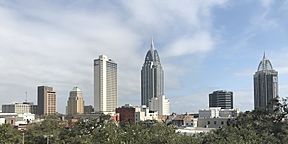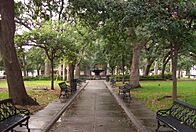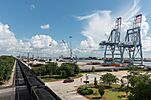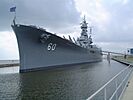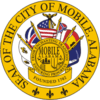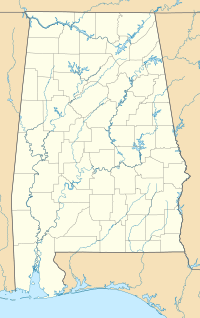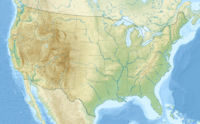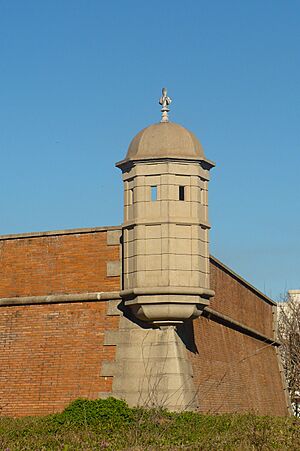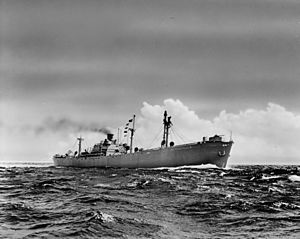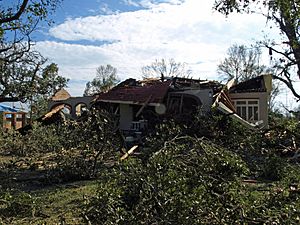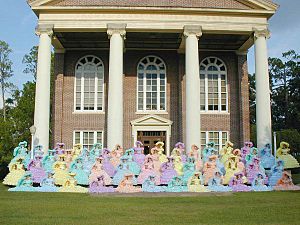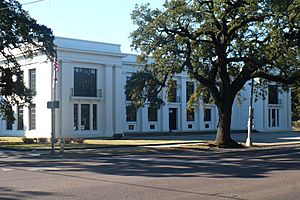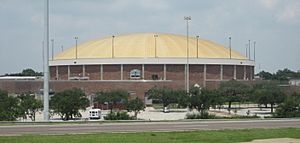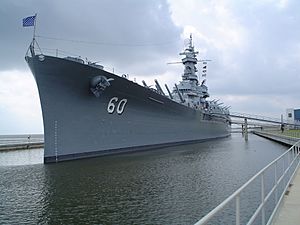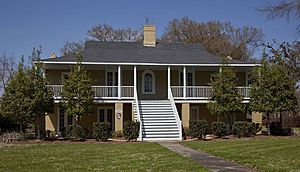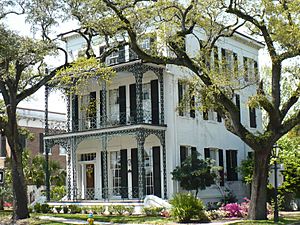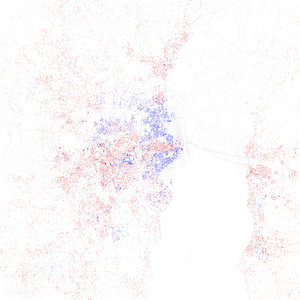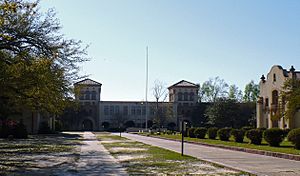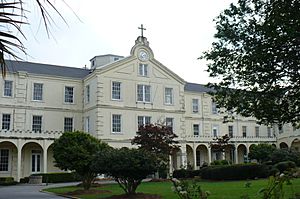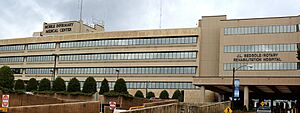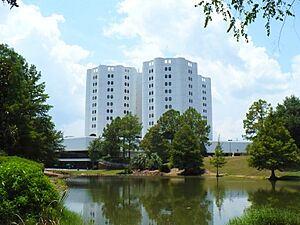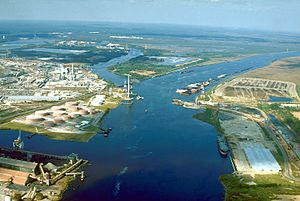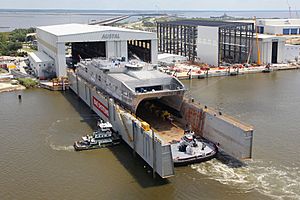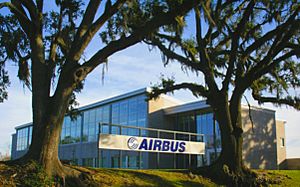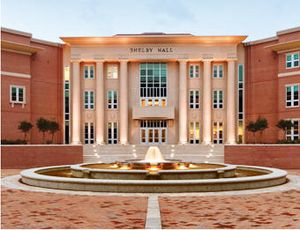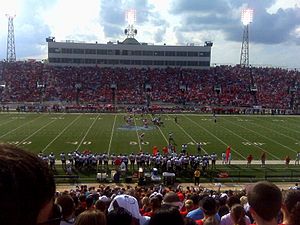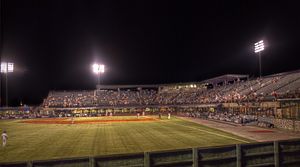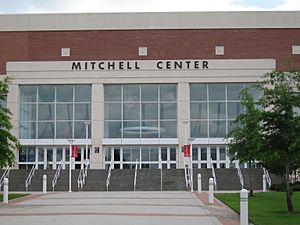Mobile, Alabama facts for kids
Quick facts for kids
Mobile
|
|||||
|---|---|---|---|---|---|
|
|
|||||
|
|||||
| Nickname(s):
"The Port City", "Azalea City", "The City of Six Flags"
|
|||||
| Country | United States | ||||
| State | Alabama | ||||
| County | Mobile | ||||
| Founded | 1702 | ||||
| Incorporated (town) | January 20, 1814 | ||||
| Incorporated (city) | December 17, 1819 | ||||
| Government | |||||
| • Type | Mayor-Council | ||||
| Area | |||||
| • City | 180.07 sq mi (466.39 km2) | ||||
| • Land | 139.48 sq mi (361.26 km2) | ||||
| • Water | 40.59 sq mi (105.14 km2) | ||||
| • Urban | 220.75 sq mi (571.7 km2) | ||||
| • Metro | 1,229 sq mi (3,184 km2) | ||||
| Elevation | 33 ft (10 m) | ||||
| Population
(2020)
|
|||||
| • City | 187,041 | ||||
| • Estimate
(2022)
|
183,289 | ||||
| • Rank | US: 141st AL: 4th |
||||
| • Density | 1,314/sq mi (507.4/km2) | ||||
| • Urban | 321,907 (US: 126th) | ||||
| • Urban density | 1,458.3/sq mi (563.0/km2) | ||||
| • Metro | 411,640 (US: 133rd) | ||||
| • Metro density | 335/sq mi (129.2/km2) | ||||
| • Combined | 665,147 (US: 79th) | ||||
| • Combined density | 172.6/sq mi (66.63/km2) | ||||
| Demonym(s) | Mobilian | ||||
| Time zone | UTC−6 (Central (CST)) | ||||
| • Summer (DST) | UTC−5 (CDT) | ||||
| ZIP Codes |
Zip codes
|
||||
| Area code(s) | 251 | ||||
| FIPS code | 01-50000 | ||||
| GNIS feature ID | 2404278 | ||||
Mobile (/moʊˈbiːl/ MOH-beel) is a city in Alabama, United States. It is the main city of Mobile County. In 2020, about 187,041 people lived there. After some areas joined the city in 2023, Mobile's population grew to over 204,000. This makes it the fourth-largest city in Alabama.
Mobile is Alabama's only saltwater port. It sits on the Mobile River near the Mobile Bay and the Gulf Coast. The Port of Mobile has always been very important for the city's economy. It started as a trading spot for French colonists and Native Americans. Today, it is one of the largest ports in the United States.
The French founded Mobile in 1702. It was the first capital of Louisiana. For its first 100 years, Mobile was ruled by France, then Great Britain, and finally Spain. In 1813, Mobile became part of the United States. During the American Civil War, the city surrendered to Union forces in 1865.
Mobile is known as a cultural center on the Gulf Coast. It has art museums, a symphony orchestra, and ballet. Mobile is also famous for having the oldest Mardi Gras celebrations in the United States. French settlers started this festival in the early 1700s. In 1830, Mobile had the first organized Mardi Gras parade in the U.S.
Contents
- Understanding Mobile's Name
- A Look at Mobile's Past
- Mobile's Location and Weather
- Mobile's Culture and Fun Activities
- Visiting Mobile: Museums and Parks
- Who Lives in Mobile?
- Learning in Mobile: Schools and Colleges
- Famous People from Mobile
- Healthcare in Mobile
- Mobile's Economy and Jobs
- Getting Around Mobile
- Mobile's Media and News
- Sports in Mobile
- Mobile's Sister Cities
- See also
Understanding Mobile's Name
The city of Mobile got its name from the Mobile tribe. These Native Americans lived near Mobile Bay when French colonists arrived. Some historians think they might be related to a tribe that hid warriors in a town called Mabila in 1540. This was before an attack on Spanish explorer Hernando de Soto.
A Look at Mobile's Past
Mobile's Early Days as a Colony
European settlement in Mobile began with French colonists. In 1702, they built Fort Louis de la Louisiane on the Mobile River. This was the first capital of the French colony of La Louisiane. Two French Canadian brothers, Pierre Le Moyne d'Iberville and Jean-Baptiste Le Moyne de Bienville, founded it. They wanted to control France's claims in Louisiana.
In 1704, a ship brought 23 French women to the colony. Many colonists and Native Americans got sick and died from a disease from this ship. This was also when the first African slaves arrived in Mobile. The number of people in the colony went up and down because of diseases.
Because of more sickness and floods, the settlement moved in 1711. It moved a few miles downriver to where Mobile is today. A new fort, Fort Louis, was built there. By 1712, about 400 people lived in the colony.
In 1720, the capital of La Louisiane moved to Biloxi. Mobile then became a military and trading center. In 1723, a new brick fort was built and named Fort Condé.
In 1763, the Treaty of Paris ended the Seven Years' War. Britain won and took over French lands east of the Mississippi River. This area became part of the British West Florida colony. The British renamed Fort Condé to Fort Charlotte.
Many French colonists stayed in Mobile. The first Jewish settlers came to Mobile in 1763. They were allowed because of the new British rule and religious freedom. Before this, Jews were not allowed in French colonies. These Jewish settlers were often merchants and traders.
During the American Revolutionary War, Mobile became a safe place for people loyal to Britain. In 1779, Spain joined the war against Britain. Spanish Governor Bernardo de Galvez captured Mobile in 1780. The Spanish renamed the fort Fortaleza Carlota. Spain held Mobile until 1813, when the United States took it over during the War of 1812.
Mobile in the 1800s
By 1813, Mobile's population was only about 300 people. It became part of the Mississippi Territory and then the Alabama Territory. When Alabama became a state in 1819, Mobile's population had grown to 809.
As cotton farms grew in Alabama and Mississippi, Mobile's population grew quickly. Many lawyers, doctors, and merchants moved there. Mobile was a great place for trade because it was connected to a river system. This system served most of Alabama and parts of Mississippi. By 1822, the city had 2,800 people.
From the 1830s, Mobile became a big city for trade, especially in cotton and the slave trade. Many enslaved people were brought to Mobile by ship. Businesses in the city supported the slave trade. By 1840, Mobile was second only to New Orleans in cotton exports.
Mobile's economy depended a lot on cotton. The last enslaved people brought to the U.S. from Africa arrived in Mobile on the ship Clotilde. One of them, Cudjoe Lewis, was the last survivor of this slave trade.
By 1860, Mobile had 29,258 people. It was the 27th largest city in the U.S. and the 4th largest in the Confederate States of America.
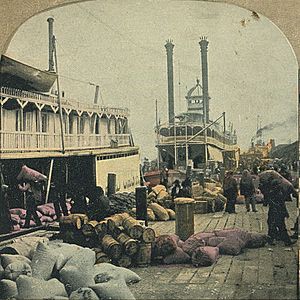
During the American Civil War, Mobile was a Confederate city. The H. L. Hunley, the first submarine to sink an enemy ship, was built here. A famous naval battle, the Battle of Mobile Bay, happened here in 1864. The Union took control of Mobile Bay. On April 12, 1865, Mobile surrendered to the Union army.
On May 25, 1865, about 300 people died in Mobile. An explosion at a federal ammunition depot caused fires that destroyed the northern part of the city.
After the Civil War, the city faced economic problems. The value of exports dropped a lot.
Mobile in the 1900s
The early 1900s brought new industries to Mobile. This created new jobs and the population grew from 40,000 in 1900 to 60,000 by 1920. The city also received money to make its shipping channels deeper. Shipbuilding and steel production became very important industries.
However, social justice and race relations became worse. In 1901, a new state law made it harder for many Black people and poor white people to vote. In 1902, Mobile passed a law to separate city streetcars by race. Black people boycotted the streetcars for two months, but the law stayed. More Jim Crow laws were passed to keep white people in power.
During World War II, many people moved to Mobile to work in shipyards and at Brookley Army Air Field. Between 1940 and 1943, over 89,000 people moved to Mobile.
Mobile was one of 18 U.S. cities that built Liberty ships. The Alabama Drydock and Shipbuilding Company (ADDSCO) built ships faster than enemy forces could sink them. This rapid growth led to crowded conditions and social tensions.
In May 1943, a race riot happened at the shipyards. ADDSCO had promoted 12 Black workers to welder jobs, which were usually for white workers. White workers rioted against this change.
After the war, Mobile lost many jobs as defense industries slowed down. But the paper and chemical industries started to grow. In the 1950s, Mobile began to integrate its police force. Spring Hill College also started accepting students of all races. By the early 1960s, city buses and lunch counters were no longer segregated.
In 1963, three African-American students sued the Mobile County School Board. They were denied entry to Murphy High School. A court ordered them to be admitted in 1964, which started the desegregation of Mobile County's schools.
The Civil Rights Movement led to new laws in the 1960s. These laws ended legal segregation and helped African Americans regain their voting rights. However, Mobile's government structure still made it hard for minority groups to elect their chosen leaders.
In 1969, Brookley Air Force Base closed. This caused a lot of job loss and economic problems for Mobile. The city's economy struggled through the 1970s.
In 1982, Mobile's government system was changed. Instead of three leaders elected by everyone, seven leaders would be elected from smaller areas. This allowed more women and African Americans to be elected to the city council.
In the late 1980s, Mayor Mike Dow and the city council started a plan to improve Mobile. They built new facilities and restored historic buildings downtown. They also worked to attract new businesses.
Mobile's Location and Weather
Where is Mobile Located?
Mobile is in the southwestern part of Alabama. The city covers about 159.4 square miles. About 117.9 square miles are land, and 41.5 square miles are water. The city's elevation ranges from 10 feet downtown to 211 feet at the Mobile Regional Airport.
Mobile's Neighborhoods
Mobile has many famous historic neighborhoods. These include Ashland Place, Campground, Church Street East, De Tonti Square, Leinkauf, Lower Dauphin Street, Midtown, Oakleigh Garden, Old Dauphin Way, Spring Hill, and Toulminville.
Mobile's Climate and Weather
| Weather chart for Mobile | |||||||||||||||||||||||||||||||||||||||||||||||
|---|---|---|---|---|---|---|---|---|---|---|---|---|---|---|---|---|---|---|---|---|---|---|---|---|---|---|---|---|---|---|---|---|---|---|---|---|---|---|---|---|---|---|---|---|---|---|---|
| J | F | M | A | M | J | J | A | S | O | N | D | ||||||||||||||||||||||||||||||||||||
|
5.6
61
40
|
5.1
64
43
|
6.1
71
49
|
4.8
78
55
|
5.1
85
64
|
6.1
89
70
|
7.3
91
73
|
7
91
73
|
5.1
87
68
|
3.7
79
58
|
5.1
71
49
|
5.1
63
42
|
||||||||||||||||||||||||||||||||||||
| temperatures in °F precipitation totals in inches |
|||||||||||||||||||||||||||||||||||||||||||||||
|
Metric conversion
|
|||||||||||||||||||||||||||||||||||||||||||||||
Mobile has a mild subtropical climate. Summers are hot and humid, and winters are mild and rainy. The lowest temperature ever recorded was -1°F in 1899. The highest was 105°F in 2000.
Mobile is known as the wettest city in the lower 48 states. It gets about 66.3 inches of rain each year. Snow is very rare in Mobile.
Major tropical storms and hurricanes sometimes affect Mobile. In 1979, Hurricane Frederic caused a lot of damage. Mobile also had damage from Hurricane Opal in 1995 and Hurricane Ivan in 2004.
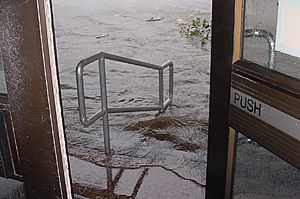
In 2005, Hurricane Katrina caused millions of dollars in damage. A storm surge of 11.45 feet flooded parts of downtown and other areas.
| Climate data for Mobile, Alabama (Mobile Regional Airport, 1981–2010) | |||||||||||||
|---|---|---|---|---|---|---|---|---|---|---|---|---|---|
| Month | Jan | Feb | Mar | Apr | May | Jun | Jul | Aug | Sep | Oct | Nov | Dec | Year |
| Record high °F (°C) | 83 (28) |
84 (29) |
91 (33) |
94 (34) |
100 (38) |
102 (39) |
104 (40) |
105 (41) |
103 (39) |
95 (35) |
87 (31) |
81 (27) |
105 (41) |
| Mean daily maximum °F (°C) | 60.8 (16.0) |
64.4 (18.0) |
71.2 (21.8) |
77.5 (25.3) |
84.6 (29.2) |
89.3 (31.8) |
91.0 (32.8) |
90.7 (32.6) |
87.0 (30.6) |
79.2 (26.2) |
70.7 (21.5) |
62.7 (17.1) |
77.4 (25.2) |
| Mean daily minimum °F (°C) | 40.0 (4.4) |
43.3 (6.3) |
49.2 (9.6) |
55.4 (13.0) |
63.7 (17.6) |
70.4 (21.3) |
72.7 (22.6) |
72.6 (22.6) |
68.0 (20.0) |
57.6 (14.2) |
48.6 (9.2) |
42.2 (5.7) |
57.0 (13.9) |
| Record low °F (°C) | 3 (−16) |
−1 (−18) |
21 (−6) |
32 (0) |
43 (6) |
49 (9) |
62 (17) |
57 (14) |
42 (6) |
30 (−1) |
22 (−6) |
8 (−13) |
−1 (−18) |
| Average precipitation inches (mm) | 5.64 (143) |
5.11 (130) |
6.14 (156) |
4.79 (122) |
5.13 (130) |
6.10 (155) |
7.26 (184) |
6.96 (177) |
5.11 (130) |
3.69 (94) |
5.13 (130) |
5.06 (129) |
66.12 (1,679) |
| Average snowfall inches (cm) | 0.1 (0.25) |
0.1 (0.25) |
0.1 (0.25) |
0 (0) |
0 (0) |
0 (0) |
0 (0) |
0 (0) |
0 (0) |
0 (0) |
0 (0) |
0.1 (0.25) |
0.4 (1) |
| Average precipitation days (≥ 0.01 in) | 9.9 | 8.7 | 8.6 | 7.0 | 8.1 | 11.8 | 14.7 | 13.4 | 8.8 | 6.9 | 7.9 | 9.1 | 114.9 |
| Mean monthly sunshine hours | 158 | 155 | 211 | 255 | 300 | 287 | 246 | 254 | 233 | 254 | 193 | 145 | 2,691 |
| Source 1: National Oceanic and Atmospheric Administration, Weather Channel (extremes) | |||||||||||||
| Source 2: Danish Meteorological Institute (sun, 1931–1960) | |||||||||||||
Christmas Day Tornado in Mobile
In December 2012, two tornadoes hit Mobile. On Christmas Day, a large tornado touched down. It moved quickly and damaged over 100 buildings in the Midtown area. Homes, churches, and schools were affected. The tornado was rated as an EF2.
Just days before, an EF1 tornado had also hit the city. The total damage from these tornadoes was estimated to be between $140 million and $150 million.
Mobile's Culture and Fun Activities
Mobile's history with French, Spanish, and African cultures makes it unique. This is different from other cities in Alabama. The yearly Carnival celebration is a great example of this. Mobile is where the Mardi Gras celebration started in the United States. It dates back to the early 1700s.
Mobile's Mardi Gras has changed over 300 years. It started as a quiet French Catholic tradition. Now, it's a big, multi-week celebration that includes many cultures. Mobile's official cultural helpers are the Azalea Trail Maids. They show off the friendly spirit of the South.
Some movies, like Close Encounters of the Third Kind (1977), were filmed in Mobile.
Mardi Gras: A Mobile Tradition
The Carnival season in Mobile starts in late fall and lasts through winter. Parties can begin in November, and parades start after January 5. The celebrations end on Mardi Gras night, which is the day before Ash Wednesday and the start of Lent.
In Mobile, people often use "Mardi Gras" to mean the whole Carnival season. During this time, special groups called mystic societies build colorful floats. They parade through downtown. Masked members throw small gifts, like beads, to the crowd. These societies also hold fancy parties, usually for adults.
Mardi Gras was first celebrated in Mobile in 1703. French Catholic settlers brought their traditions to the original Mobile settlement. Mobile's first Carnival group, the Boeuf Gras Society, started in 1711. Early celebrations were small private parties.
In 1830, Mobile's Cowbellion de Rakin Society was the first organized group in the U.S. to have a masked parade. They used rakes, hoes, and cowbells. In 1840, they added horse-drawn floats. The Striker's Independent Society, formed in 1843, is the oldest mystic society still active today.
Mardi Gras celebrations stopped during the American Civil War. In 1866, Joe Cain brought the parades back. He dressed as a fictional Native American chief and paraded through the streets. In 2002, Mobile celebrated its 300th birthday with parades from all the city's mystic societies.
The Conde Explorers, started in 2004, were the first integrated Mardi Gras society to parade in downtown Mobile in 2005. This group includes men and women of all backgrounds. They also do volunteer work. The Conde Explorers were featured in a documentary called The Order of Myths (2008).
Learning and Libraries in Mobile
The National African American Archives and Museum shows the history of African Americans in Mardi Gras. It also has items from the time of slavery and stories of famous African Americans. The University of South Alabama Archives keeps historical records about Mobile and southern Alabama.
The Mobile Municipal Archives holds records of the City of Mobile since 1814. Most of Mobile's colonial records (1702-1813) are in Paris, London, Seville, and Madrid. The Mobile Genealogical Society Library helps people research their family history.
The Mobile Public Library has eight branches. Its large history and family research section is at the Ben May Main Library. The Saint Ignatius Archives has items and documents about the history of Saint Ignatius Church and School and the Catholic Church in Mobile.
Arts and Fun in Mobile
The Mobile Museum of Art has art and culture from many centuries. The museum was made bigger in 2002. It has collections of African, Asian, American, and European art.
The Centre for the Living Arts runs the historic Saenger Theatre and Space 301, an art gallery. The Saenger Theatre opened in 1927 as a movie theater. Today, it hosts concerts and is home to the Mobile Symphony Orchestra. Space 301 Gallery shows modern art. The Crescent Theater in downtown Mobile shows special films.
The Mobile Civic Center has an arena, a theater, and an exhibition hall. It's a main spot for concerts and other events. It's also home to the Mobile Opera and the Mobile Ballet. The city's Arthur C. Outlaw Convention Center hosts many events.
Mobile hosts the Greater Gulf State Fair every October. It also has the Ten Sixty Five festival, a free music festival.
The Mobile Theatre Guild is a community theater group that started in 1947. The Joe Jefferson Players is Alabama's oldest continuously running community theater. Drama Camp Productions and Sunny Side Theater offer children's theater programs.
The Mobile Arts Council helps support art groups in Mobile. It was founded in 1955 to help artistic and cultural organizations work together.
Visiting Mobile: Museums and Parks
Museums to Explore
Mobile has many museums. Battleship Memorial Park is a military park on Mobile Bay. It has the World War II battleship USS Alabama, the submarine USS Drum, and other military equipment. The History Museum of Mobile shows over 300 years of Mobile's history. It is in the historic Old City Hall building. The Oakleigh Historic Complex has three house museums. They show what life was like for different people in the 1800s.
The Mobile Carnival Museum shows the history of Mardi Gras in the city. It has costumes and displays from the festival. The Bragg-Mitchell Mansion (1855), Richards DAR House (1860), and the Condé-Charlotte House (1822) are historic house museums. Fort Morgan (1819), Fort Gaines (1821), and Historic Blakeley State Park are important for American Civil War history.
The Mobile Medical Museum is in the historic Vincent-Doan House (1827). It shows the long history of medicine in Mobile. The Phoenix Fire Museum shows the history of fire companies in Mobile. The Mobile Police Department Museum shows the history of law enforcement.
The Gulf Coast Exploreum Science Center is a science museum downtown. It has exhibits, an IMAX theater, and a chemistry lab. The Dauphin Island Sea Lab is south of the city. It has an aquarium called the Estuarium, which shows the different habitats of the Mobile Bay area.
Parks and Fun Places
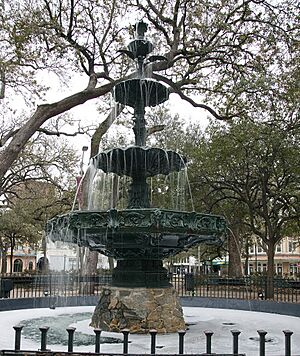
The Mobile Botanical Gardens cover 100 acres. They have a large collection of Rhododendrons and a Longleaf Pine Habitat. Bellingrath Gardens and Home is a 65-acre botanical garden and historic mansion. The 5 Rivers Delta Resource Center helps visitors learn about the Mobile River Delta. It offers boat tours, exhibits, and walking trails.
Mobile has over 45 public parks. Bienville Square is a historic park downtown. It's named after Mobile's founder, Jean-Baptiste Le Moyne, Sieur de Bienville. It's a popular gathering place. Cathedral Square is a park for performing arts. It's near the Cathedral Basilica of the Immaculate Conception.
The Fort of Colonial Mobile is a rebuilt version of the original Fort Condé. It's a welcome center and a living history museum. Spanish Plaza is a park that honors Mobile's Spanish history. It has a fountain given to Mobile by the city of Málaga, Spain. Langan Park is the largest park at 720 acres. It has lakes, the Mobile Museum of Art, a golf course, and the Mobile Botanical Gardens.
Mobile's Historic Buildings
Mobile has many old buildings in different styles. These include Greek Revival, Gothic Revival, Italianate, and Creole cottage. Later styles include Victorian, Colonial Revival, and Spanish Colonial Revival. The city has nine main historic districts.

Many historic churches are in Mobile. These include Christ Church Cathedral and the Cathedral Basilica of the Immaculate Conception. There are also two historic Catholic convents.
Barton Academy is a historic Greek Revival school building. The Bishop Portier House and the Carlen House are examples of Creole cottages. The Mobile City Hospital and the United States Marine Hospital are old Greek Revival hospital buildings. The Washington Firehouse No. 5 is a Greek Revival fire station from 1851. The Hunter House is an Italianate-style home built by a successful African American businesswoman.
Mobile has several historic cemeteries. The Church Street Graveyard was founded in 1819. The 120-acre Magnolia Cemetery was established in 1836. It has about 80,000 burials. The Catholic Cemetery was started in 1848. Mobile's Jewish community has two historic cemeteries: Sha'arai Shomayim Cemetery and Ahavas Chesed Cemetery.
Who Lives in Mobile?
| Historical population | ||
|---|---|---|
| Year | Pop. | ±% |
| 1785 | 746 | — |
| 1788 | 1,468 | +96.8% |
| 1820 | 1,500 | +2.2% |
| 1830 | 3,194 | +112.9% |
| 1840 | 12,672 | +296.7% |
| 1850 | 20,515 | +61.9% |
| 1860 | 29,258 | +42.6% |
| 1870 | 32,034 | +9.5% |
| 1880 | 29,132 | −9.1% |
| 1890 | 31,076 | +6.7% |
| 1900 | 38,469 | +23.8% |
| 1910 | 51,521 | +33.9% |
| 1920 | 60,777 | +18.0% |
| 1930 | 68,202 | +12.2% |
| 1940 | 78,720 | +15.4% |
| 1950 | 129,009 | +63.9% |
| 1960 | 202,779 | +57.2% |
| 1970 | 190,026 | −6.3% |
| 1980 | 200,452 | +5.5% |
| 1990 | 196,278 | −2.1% |
| 2000 | 198,915 | +1.3% |
| 2010 | 195,111 | −1.9% |
| 2020 | 187,041 | −4.1% |
| 2022 (est.) | 183,289 | −2.0% |
| U.S. Decennial Census 2020 Census 2022 Estimate |
||
| Historic Racial composition | 2010 | 1990 | 1970 | 1940 |
|---|---|---|---|---|
| White | 45.0% | 59.6% | 64.3% | 63.0% |
| —Non-Hispanic | 43.9% | 58.9% | 63.5% | n/a |
| Black or African American | 50.6% | 38.9% | 35.4% | 36.9% |
| Hispanic or Latino (of any race) | 2.4% | 1.0% | 0.9% | n/a |
| Asian | 1.8% | 1.0% | 0.1% | – |
Mobile's Population in 2020
| Race | Num. | Perc. |
|---|---|---|
| White (non-Hispanic) | 75,043 | 40.12% |
| Black or African American (non-Hispanic) | 95,505 | 51.06% |
| Native American | 513 | 0.27% |
| Asian | 3,369 | 1.8% |
| Pacific Islander | 106 | 0.06% |
| Other/Mixed | 6,471 | 3.46% |
| Hispanic or Latino | 6,034 | 3.23% |
In 2020, Mobile had 187,041 people. There were 77,628 households and 41,260 families.
Mobile's Population in 2010
In 2010, 195,111 people lived in Mobile. Mobile is the center of Alabama's second-largest metropolitan area. This area includes all of Mobile County and had about 413,936 people in 2012.
In 2010, 50.6% of the city's population was Black or African American. 45.0% was White. The average household had 2.4 people. The average family had 3.07 people. The median age was 35.7 years.
Learning in Mobile: Schools and Colleges
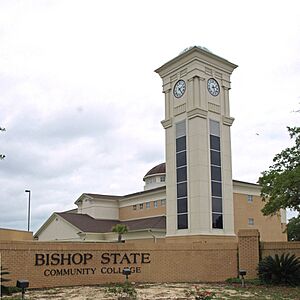
Public Schools in Mobile
The Mobile County Public School System runs the public schools in Mobile. It has about 55,200 students in 88 schools. The system employs about 7,026 people.
The State of Alabama also runs the Alabama School of Mathematics and Science in Mobile. This school is for advanced high school students. It helps identify and educate future leaders.
Private Schools in Mobile
UMS-Wright Preparatory School is a private school for boys and girls. It was formed in 1988 when two older schools merged.
Many private schools are part of the Roman Catholic Archdiocese of Mobile. These include McGill-Toolen Catholic High School (1896) and several other Catholic schools.
Other notable private schools include St. Paul's Episcopal School (1947), Mobile Christian School (1961), and Faith Academy (1967).
Colleges and Universities in Mobile
Mobile has several major colleges and universities. These include the University of South Alabama, Spring Hill College, the University of Mobile, Faulkner University, and Bishop State Community College.
Undergraduate and Graduate Studies
The University of South Alabama is a public university founded in 1963. It offers many programs, including arts, sciences, business, education, engineering, and nursing.
Faulkner University is a private university. Its Mobile campus offers bachelor's and associate degrees in subjects like Business Administration and Criminal Justice.
Spring Hill College, founded in 1830, was the first Catholic college in the Southeast. It is the third oldest Jesuit college in the U.S. It offers both undergraduate and graduate programs.
The University of Mobile is a private university founded in 1961. It offers programs in arts, sciences, business, Christian studies, education, and nursing.
Community and Vocational Colleges
Bishop State Community College, founded in 1927, is a public college. It has four campuses in Mobile and offers many associate degrees.
Several vocational schools also have campuses in Mobile. These include Fortis College, Virginia College, and Remington College.
Famous People from Mobile
Mobile is home to many notable people, including:
- Jerry Carl – U.S. representative
- Tim Cook (born 1960) – CEO of Apple Inc.
- Flo Milli (born 2000) – rapper
- Bubba Wallace (born 1993) – racing driver
Healthcare in Mobile
Mobile is a major healthcare center for the Gulf Coast. It has over 850 doctors and 175 dentists. There are four main hospitals in the city.
Mobile Infirmary Medical Center has 704 beds. It is the largest nonprofit hospital in Alabama. Providence Hospital has 349 beds. The University of South Alabama Medical Center has 346 beds. It is Mobile's only level I trauma center and a regional burn center. Springhill Medical Center has 252 beds.
The University of South Alabama also runs the Children's and Women's Hospital. This hospital is only for the care of women and children. In 2008, the USA Mitchell Cancer Center Institute opened. It is the first cancer research center in the central Gulf Coast area.
BayPointe Hospital and Children's Residential Services is the only psychiatric hospital in the city. It helps children, teenagers, and adults.
Mobile also has many outpatient surgery centers, emergency clinics, and nursing homes.
Mobile's Economy and Jobs
Mobile's main industries are aerospace, steel, shipbuilding, retail, services, construction, medicine, and manufacturing. After a few decades of economic struggles, Mobile's economy started to get better in the late 1980s. Between 1993 and 2003, about 13,983 new jobs were created.
Some companies that used to be based in Mobile include Delchamps and Gayfers. Companies currently headquartered in Mobile include AlwaysHD, Foosackly's, and Volkert, Inc.
Major Industries in Mobile
Port of Mobile
Mobile's Alabama State Docks had its biggest expansion ever in the early 2000s. It greatly increased its ability to handle and store shipping containers. This project cost over $300 million and was finished in 2005.
Shipyards
Shipbuilding returned to Mobile in 1999 with the start of Austal USA. This company builds ships for the U.S. defense and commercial uses. In 2012, Austal announced it would hire more workers, increasing its team from 3,000 to 4,500 employees.
Atlantic Marine also had a large shipyard in Mobile. It was bought by BAE Systems in 2010. Now called BAE Systems Southeast Shipyards, it continues to operate as a full-service shipyard.
Mobile Aeroplex at Brookley
The Mobile Aeroplex at Brookley is a large industrial area and airport south of downtown. It's the biggest industrial and transportation complex in the region. It has over 70 companies, many of them in aerospace.
In 2012, Airbus announced plans to build an aircraft assembly plant in Mobile. This $600 million factory builds A319, A320, and A321 aircraft. It was planned to create about 1,000 full-time jobs. Construction started in 2013, and the factory opened in 2015. It can produce up to 50 aircraft per year.
In 2017, Airbus partnered with Bombardier Aerospace. Airbus plans to open another assembly line in Mobile for CSeries aircraft, now called the Airbus A220. Production started in 2019.
ThyssenKrupp
In 2007, German company ThyssenKrupp started building a large steel processing plant north of Mobile. It cost $4.65 billion. The plant began operating in 2010.
Top Employers in Mobile
Here are some of the largest employers in Mobile:
| # | Employer | # of Employees | Percentage |
|---|---|---|---|
| 1 | Mobile County Public School System | 7,200 | 3.85% |
| 2 | Infirmary Health Systems | 6,400 | 3.42% |
| 3 | University of South Alabama | 6,400 | 3.21% |
| 4 | Austal USA | 4,000 | 2.14% |
| 5 | City of Mobile | 2,000 | 1.07% |
| 6 | Airbus U.S. Manufacturing | 1,800 | 0.96% |
| 7 | AltaPointe | 1,700 | 0.91% |
| 8 | AM/NS Calvert | 1,600 | 0.85% |
| 9 | Springhill Medical Center | 1,600 | 0.85% |
| 10 | Mobile County | 1,600 | 0.85% |
| — | Total | 33,900 | 18.11% |
Unemployment Rate in Mobile
The unemployment rate shows how many people who want to work cannot find jobs.
| Mobile | Mobile County |
Mobile Metropolitan Statistical Area |
Alabama | United States |
|
|---|---|---|---|---|---|
| January 2023 | 3.6% | 3.3% | 3.3% | 2.8% | 3.4% |
| December 2023 | 3.9% | 3.6% | 3.6% | 2.8% | 3.7% |
| January 2024 | 5.0% | 4.5% | 4.5% | 2.9% | 3.7% |
| February 2024 | — | — | — | — | 3.9% |
Getting Around Mobile
Air Travel in Mobile
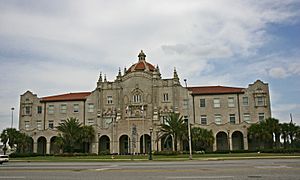
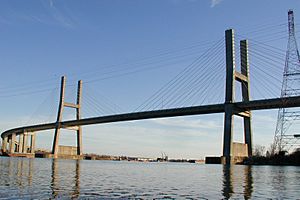
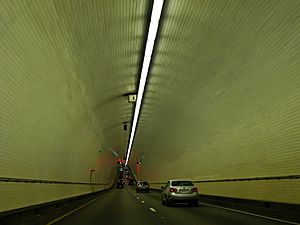
Passengers flying to or from Mobile use the Mobile Regional Airport. It has direct flights to major airports like Dallas/Fort Worth, Charlotte, Houston, and Atlanta. The Mobile Downtown Airport at the Brookley Aeroplex is used for corporate, cargo, and private planes.
Bike Paths in Mobile
The Three Mile Creek Greenway Trail is being built to connect different parts of Mobile. This path will be seven miles long and include sidewalks and bike lanes. It aims to make Mobile's waterways more accessible for fun.
Other bike trails include the Mobile Airport Perimeter Trail and mountain biking trails at the University of South Alabama.
Train Travel in Mobile
Mobile is served by four major railroads: Canadian National Railway, CSX Transportation, Kansas City Southern Railway, and Norfolk Southern Railway. These railroads connect to the Port of Mobile, which helps companies move goods.
Mobile used to have passenger train service with Amtrak's Sunset Limited until 2005. Efforts are being made to restart passenger train service between Mobile and New Orleans.
Public Transportation in Mobile
The Wave Transit System provides bus service in Mobile. Buses run Monday through Saturday. Baylinc is another bus service that connects eastern Baldwin County to downtown Mobile.
Greyhound Lines offers bus service to other cities across the United States. Mobile also has taxi and limousine services.
Roads and Tunnels in Mobile
Two major interstate highways meet in Mobile. Interstate 10 runs through the city, and Interstate 65 starts in Mobile and goes north. Interstate 165 connects to I-65 north of the city.
Mobile has several ways to cross the Mobile River and Mobile Bay. Interstate 10 goes through the George Wallace Tunnel and then over the Jubilee Parkway. US 98 goes through the Bankhead Tunnel. US 90 crosses the Cochrane–Africatown USA Bridge.
Water Travel in Mobile
The Port of Mobile has deepwater terminals. These terminals connect to 1,500 miles of waterways, including the Great Lakes and the Ohio and Tennessee rivers. The port handles many types of cargo. It also has companies that build and repair ships.
Mobile was once a home port for Carnival Cruise Lines. Cruise ships like the Carnival Fantasy and Carnival Elation sailed from Mobile. In 2011, Carnival stopped its cruise operations from Mobile. However, in 2015, Carnival announced that the Carnival Fantasy would return to Mobile. It started offering cruises to Mexico in 2016.
Mobile's Media and News
Print Media in Mobile
Mobile's Press-Register is Alabama's oldest newspaper, first published in 1813. It covers news in Mobile and Baldwin counties. Lagniappe is Mobile's alternative newspaper. Mobile Bay Monthly is a local magazine.
Television in Mobile
Mobile has several local TV stations. These include WKRG (CBS), WALA (Fox), WPMI (NBC), and WFNA (The CW). Mobile is part of the Mobile–Pensacola–Fort Walton Beach TV market.
Radio in Mobile
There are 55 radio stations that serve the Mobile area. These include FM stations like WAVH, WBLX, and WKSJ, and AM stations like WBHY and WMOB. They play music from Christian Contemporary to Hip hop.
Sports in Mobile
Football in Mobile
Mobile has two football stadiums. The Ladd-Peebles Stadium opened in 1948 and holds over 40,000 people. Hancock Whitney Stadium opened in 2020 on the University of South Alabama campus and holds over 25,000.
Mobile has hosted the Senior Bowl since 1951. This game features the best college football players. It moved to Hancock Whitney Stadium in 2021.
The 68 Ventures Bowl is also played in Mobile. It features teams from the Sun Belt and Mid-American conferences.
The University of South Alabama started its football team in 2007. They play at Hancock Whitney Stadium.
Baseball in Mobile
Mobile's Hank Aaron Stadium was home to the Mobile BayBears baseball team until 2019. Five members of the Baseball Hall of Fame are from Mobile: Satchel Paige, Billy Williams, Willie McCovey, Hank Aaron, and Ozzie Smith.
Basketball in Mobile
The South Alabama basketball team often competes for the Sun Belt Conference championship. They play their home games at the Mitchell Center.
Other Sports and Facilities
The Archbishop Lipscomb Athletic Complex is home to AFC Mobile, a soccer team.
The Mobile Tennis Center has over 50 lighted hard courts.
For golf, Magnolia Grove is part of the Robert Trent Jones Golf Trail. It has 36 holes. The Falls course was named the best par 3 course in America.
Mobile also hosts the Azalea Trail Run, a 10k race through historic Mobile. It attracts runners from all over the world.
Mobile's Sister Cities
Mobile has special connections with cities around the world. These are called sister cities:
- Ariel, West Bank
- Bolinao, Philippines (2005)
- Cockburn, Australia (2005)
- Constanța, Romania
- Gaeta, Italy
- Havana, Cuba (1993)
- Heze, China
- Ichihara, Japan (1993)
- iLembe, South Africa
- Katowice, Poland (1990)
- Košice, Slovakia (1992)
- Pyeongtaek, South Korea
- Tianjin, China
- Veracruz, Mexico
- Worms, Germany (1974)
See also
 In Spanish: Mobile (Alabama) para niños
In Spanish: Mobile (Alabama) para niños


